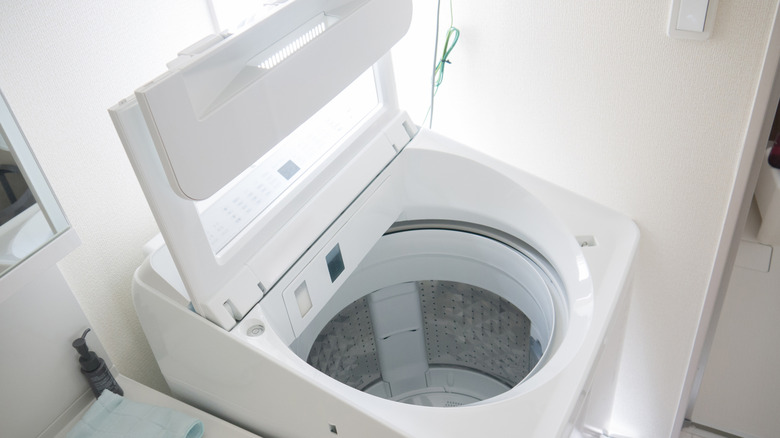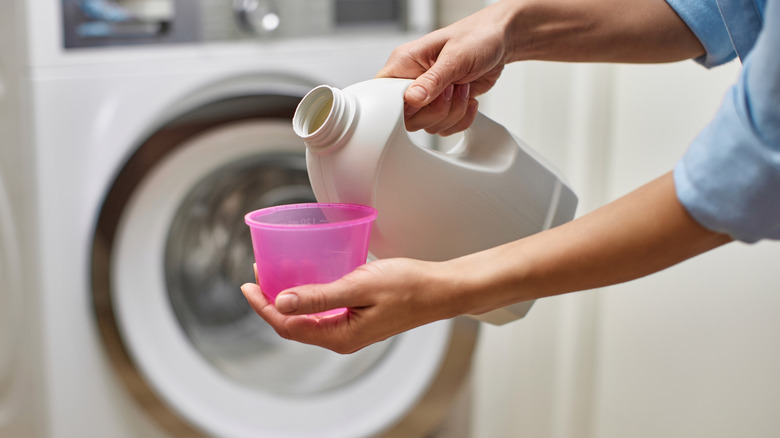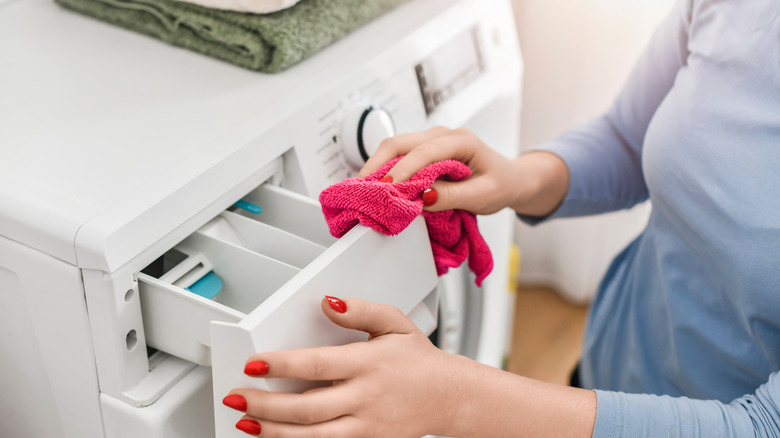How To Clean A Top-Load Washing Machine So It Shines Like New
Sometimes it is easy to forget that the items in our home that help us clean things also need to be cleaned on occasion. And, regardless of which brand your top-loading washing machine is, it is one of those things. Though it may seem counterintuitive, your washer is constantly fighting a losing battle against detergent residue, mildew, mineral deposits from hard water, and even mold. Over time, these nasty remnants build up in the drum, the detergent dispenser, and the plumbing, creating a funky smell that's telling you it is time for a cleaning. Just like you wouldn't use a dirty sponge to clean your dishes or a dirty toothbrush to clean your teeth, you probably do not want to use a dirty washer to clean your clothes.
Maintaining a sparkling clean machine is not just about eliminating curious smells. It is also about protecting the financial investment you made in your washing machine. A clogged and unclean washer can strain its motor and plumbing, which in turn can lead to costly repairs and potentially shorten its lifespan. Fortunately, keeping your top-loader in peak condition is a quick and easy task. Experts recommend performing a deep clean cycle about once a month in order to prevent the kind of buildup that leads to those unpleasant odors. Think of it as preventative maintenance; a little effort now saves you a lot of headache — and money — later. A clean washer ensures that every load of your laundry starts in a sanitized environment and comes out fresh and truly clean every single time.
Properly deep cleaning your washer's interior
The best way to deep clean your washer is to target the unseen grime in the drum and plumbing, which is the key to eliminating odors at the source. First, ensure your washer is completely empty. Next, choose your cleaning agent. For a great, all-purpose clean that fights residue as well as mineral deposits, we recommend a one-two punch combo of white vinegar and baking soda. Pour about four cups of white vinegar directly into the drum, then run the cycle on the hottest water setting available with the largest load size. If your machine has a dedicated "Clean Tub" or "Sanitize" cycle, use that. After the washer fills and begins to agitate, pause the cycle and let the vinegar solution soak for at least 30 minutes (or even up to an hour) to give it enough time to break down any stubborn gunk.
After soaking, resume the cycle. As the wash cycle nears the end, add about one cup of baking soda to the drum to scour and deodorize. If your machine has a severe mold or mildew problem, consider opting for a more potent commercial cleaner like liquid chlorine bleach solution (roughly one cup of bleach) instead of vinegar. For safety, never mix bleach and vinegar, as this creates toxic chlorine gas. Whichever method you choose, after the full cycle completes, run a second empty wash cycle on hot water alone. This final rinse flushes out any remaining residue and ensures that your machine is cleared out and ready for your next load of laundry.
Getting the rest of your washer to gleam
While the cleaning cycle works wonders on your washer's drum, that isn't the only part of your machine that needs attention. To achieve that shiny brand new vibe, you need to manually tackle these other, often-forgotten areas. Start by making a simple cleaning solution of equal parts warm water and white vinegar, or a few drops of mild dish soap in water; this mixture is gentle and perfect for external components. Grab a clean microfiber cloth and an old toothbrush, too, for scrubbing.
First, focus on detergent and fabric softener dispensers, since they are notorious for attracting sticky, moldy gunk. If they are removable, soak them in your cleaning solution for about 15 minutes, then use the toothbrush to scrub away the buildup. For fixed dispensers, pour the solution directly into them, let it sit, then detail the crevices with the brush. Next, pay special attention to the rim of the tub (the top visible lip of the drum), as it's where water and scum tend to build up. Wipe this area down thoroughly. Then, grab that microfiber cloth and help keep the laundry room appliance clean and lint-free by wiping down the sides, control panel, and lid.
The final — and most important — step is to always leave the lid slightly open between cycles. This allows the washer's drum to air dry completely, stopping moisture from trapping odors and mold. By combining the deep-clean cycle with this manual scrubbing, your top-load washing machine will look and smell as fresh as the day you brought it home.


